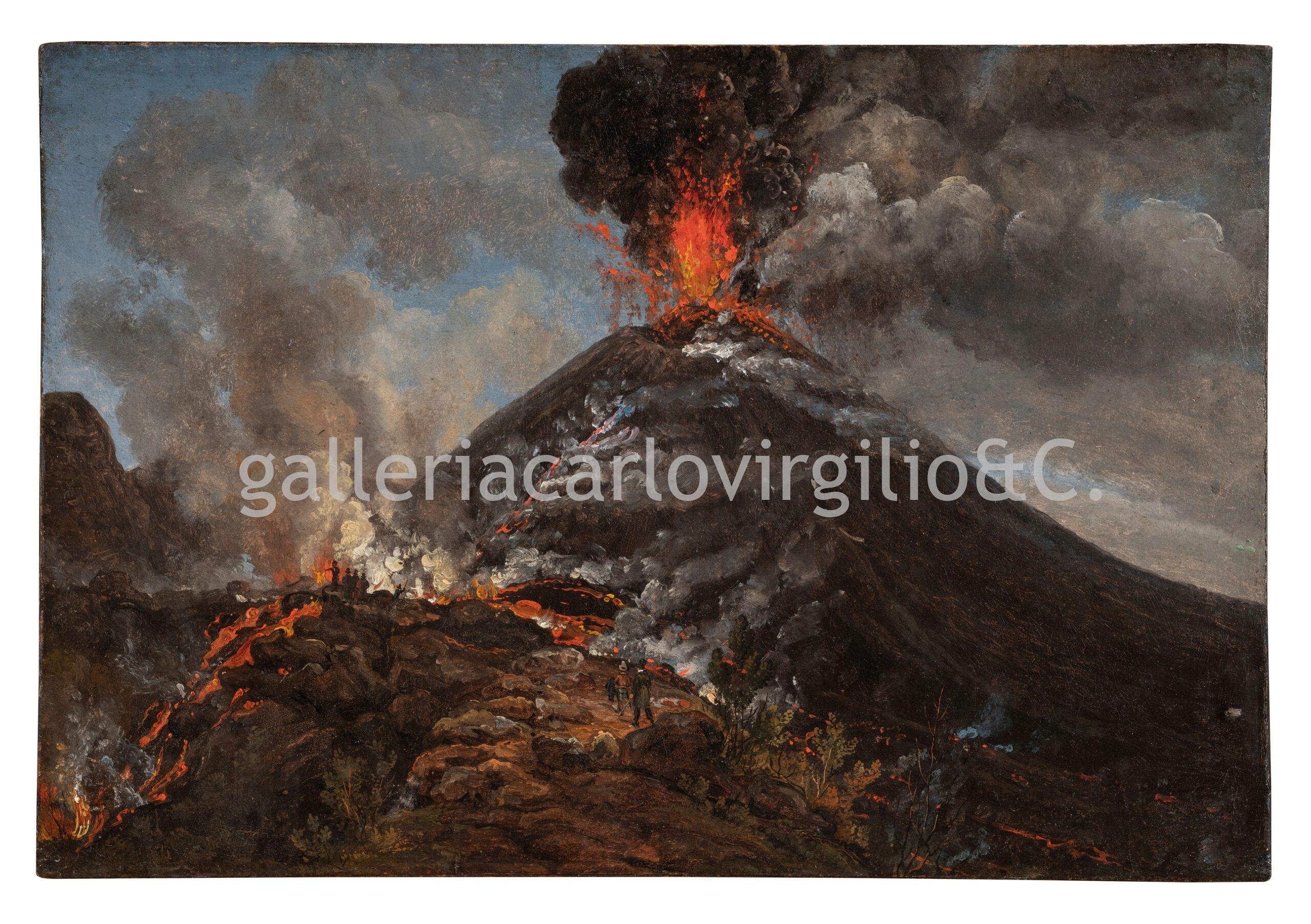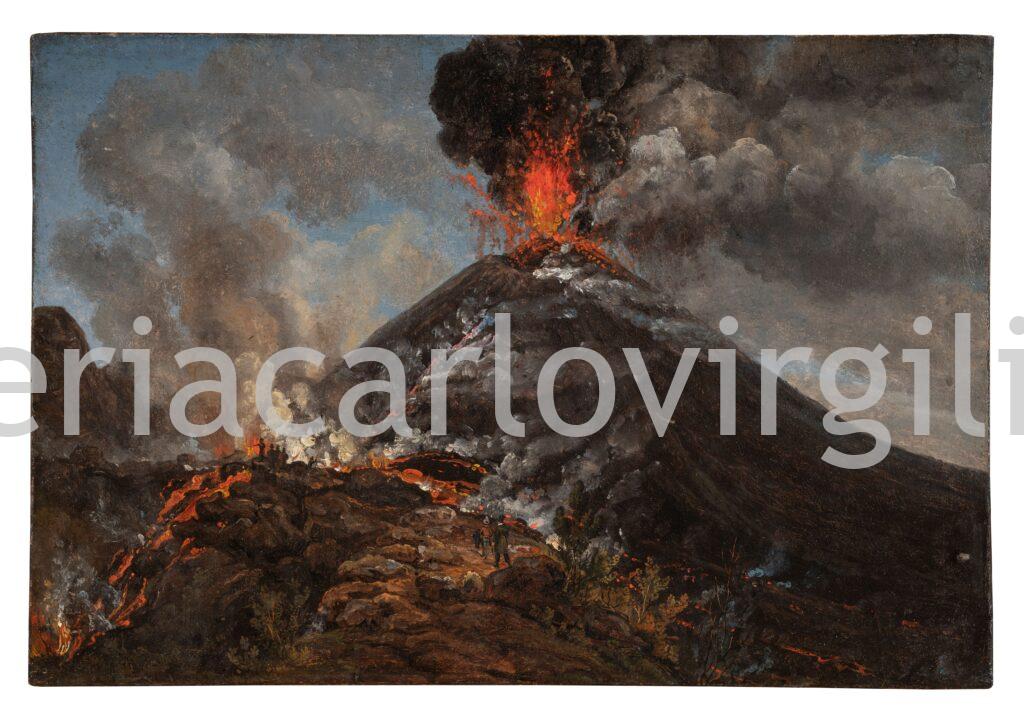| OPERA DISPONIBILE

Johan Christian Dahl
Bergen 1788 – Dresda 1857
Veduta del Vesuvio in eruzione (Il piccolo e il grande cratere del Vesuvio) • 1821
Olio su carta intelata, 28,5 × 42 cm
Identificabile con “Il piccolo e il grande cratere del Vesuvio” donato da Dahl al professor Teodoro Monticelli a Naples nel gennaio 1821;
Bibliografia: identificabile con Marie Lødrup Bang, Johan Christian Dahl 1788-1857. Life and Works, Oslo 1987, vol. 2, cat. 284, p. 115: Veduta del Vesuvio in eruzion (“Il piccolo e il grande cratere del Vesuvio”), per il professor Monticelli a Napoli, all’epoca ubicazione sconosciuta.
As soon as Vesuvius erupted on 20 December 1820 Johann Christian Dahl ascended the volcano, and he returned several times thereafter.
On 8 January 1821 the Norwegian wrote in his diary that ”Today I painted a picture of Vesuvius, which I will present to Monticelli.” Teodoro Monticelli (Brindisi 1759-Naples 1845) was a prominent Neapolitan collector and professor of chemistry whom Dahl had first met on 21 November the year before. The landscapist also wrote that he had been working from a sketch, which is believed to be a painting dated “Neapel 24 Dec. 1820,” and whose composition bears a great resemblance to this one, representing a view of the small and large craters of Vesuvius.
Open-air studies were one of Dahl’s essential tools to strengthen the credibility of his colour palette in relation to painting daylight scenes. He painted en plein air in Naples, and much earlier the Danish art critic Peder Hjort (Tårnby 1793 – Copenhagen 1871) had observed the young academy student walking in the forest with his portfolio and equipment to make plant studies in 1812, when no one else did so. However, sketches could just as well have been made in the studio from memory, which was the case for the painting in question.
The gift to Monticelli has been painted with areas in the impasto technique and appears sketchy but is a finished painting. Dahl clearly distinguished between sketches, which he considered his private notes, and finished works, but the painting style here emphasizes the increasing freedom and virtuosity he obtained in Naples, in addition to producing a good impression that is not just a veduta or naturalistic rendering, but a composition where the powerful forces of nature had been experienced up close. In any case, the Norwegian usually painted works intended as gifts very quickly.
In the vivid depiction of the volcano’s glowing lava and smoke, Dahl, unlike other artists, has painted the blue smoke rising from the crater caused by the contact between sulphur emissions and oxygen. This phenomenon interested Monticelli the scientist as well as Dahl the artist. The latter perceived it as a characteristic of Vesuvius and its location, just as he was attentive to atmospheric phenomena, tone, light-effects and moonlight throughout his stay in Naples. The crucial importance he ascribed to these was the reason he noted the place and date on his sketches, as he did on this occasion. The idea that these characteristics described the individual locality meant that he could omit figures with a folkloric touch.
The figure with his back turned, standing with a cane in the foreground of the picture, is very likely the Danish crown prince, Christian Frederik, later King Christian VIII (Copenhagen 1786-1848 ibid). He was on his Grand Tour in the company of his wife, Princess Caroline Amalie (Copenhagen 1796-1881 ibid), and spent most of 1820 in Naples. Indeed the crown prince had invited Dahl to come and stay with them.
Furthermore, mineralogy was among the crown prince’s interests, which is why he had contacted Monticelli, with whom he maintained a lifelong friendship. Monticelli was dedicated to the study of Vesuvius, and in 1815 he had already begun publishing about a previous eruption. In March 1820, Christian Frederik gave his lecture on the minerals in the lava flows of Vesuvius at the Società Reale delle Scienze in Naples.
What is more, the figure with his back turned resembles a figure in another work thought to represent the crown prince. In the painting Quisisana seen from a Terrace with the Royal Household, 1820, that the Dane had commissioned from Dahl as a gift for Ferdinand I of the Two Sicilies (Naples 1751-1825 ibid.) a similar, pointing figure with his back turned is seen alongside the princess. The Quisisana painting was a thank you to the king for having lent the country castle Quisisana to the Danes. The property was located south of Castellammare di Stabia, and today hosts the Museo Archeologico di Stabia Libero D’Orsi.
However, the gift to Monticelli was painted after the crown prince and his wife had departed and was probably a farewell gift. The royals and Dahl left Quisisana at the end of October, but the landscapist continued to associate with the crown prince until the latter’s departure for Rome on 29 November. They would meet again there. In October, Dahl moved into lodgings on the Pizzofalcone hill until he too travelled from Naples to Rome on 3 February 1821, and almost five months later continued from there back to Dresden.
The eruption of Vesuvius was a popular motif. On the day that Dahl dated the above-mentioned sketch, Christmas Eve 1820, he signed and dated another painting in which the eruption is seen from higher up. He painted it for himself, but in 1821 he repeated the motif twice more out of a total of seven times.
In Rome Dahl also got to know the Danish sculptor Bertel Thorvaldsen (Copenhagen 1770-1848 ibid), and among many other works, he executed ten paintings for his collection, four of which were moonlight scenes from Naples.
The large number of works reflects Dahl’s productivity and the marketability of his landscape paintings in general, something that he had already benefited from. As a landscapist trained at the Danish Academy of Fine Arts, he could only exceptionally be granted financial travel support. Dahl did not obtain this and his journeys from Copenhagen to Dresden in 1818 and from there to Naples in 1820 had been at his own expense. Only the two months staying with the Danish royal family at Quisisana was an indirect contribution. The trip to Naples and Rome in 1820-1821 was Dahl’s only trip to Italy.
Laila Skjøthaug
BIBLIOGRAPHY
De Ceglia 2012
Francesco Paolo De Ceglia, Teodoro Monticelli, in Treccani Dizionario Biografico degli Italiani, vol 76, 2012, accessed online 5. February 2025 https://www.treccani.it/enciclopedia/teodoro-monticelli_(Dizionario-Biografico)/
J.C. Dahl i Italien1987
J.C. Dahl i Italien 1820-1821, exhibition catalogue Thorvaldsens Museum, Copenhagen 8 October – 29 November 1987, edited by Marie Lødrup Bang, Dyveke Helsted, Eva Henschen, Bjarne Jørnæs, Copenhagen 1987.
Lødrup Bang 1987
Marie Lødrup Bang, Johan Christian Dahl 1788-1857. Life and Works, Oslo 1987.
Christian Frederik [1815-1821] 1973
Christian Frederik, (transcription of diary and notes) in Kong Christian VIII.s dagbøger og optegnelser, published by Albert Fabritius et al, Det Kongelige Danske Selskab for Fædrelandets historie, II, 1. halvbind 1815-1821, Copenhagen 1973.
Gelius 2003
Wilhelm Gelius, Dahl i Danmark, in J.C. Dahl i Danmark, exhibition catalogue Thorvaldsens Museum, Copenhagen 17 September – 14 December 2003, edited by William Gelius, Stig Miss, Copenhagen 2003.
Helsted 1987
Dyveke Helsted, Dahl og prins Christian Frederik, in J.C. Dahl i Italien,1987, p. 32-36.
Helsted 1987cat.
Dyveke Helsted, Landskab med Quisisana og det kongelige selskab, in J.C. Dahl i Italien, 1987, p. 70-71 cat. 32.
Helsted 1989
Dyveke Helsted, Thorvaldsen collezionista di arte moderna, in Bertel Thorvaldsen 1770-1844 scultore danese a Roma, exhibition catalogue Galleria Nazionale d’Arte Moderna, Rome 31 October 1989 – 28 January 1990, edited by Elena di Majo, Bjarne Jørnæs, Stefano Sussino, Rome 1989, p. 241-243.
Hjort 1854
Peder Hjort, Kritiske Bidrag til Nyere dansk Tænkemådes og Dannelses Historie, Copenhagen 1854.
Jørnæs 1987
Bjarne Jørnæs, Vesuv i udbrud, in J.C. Dahl i Italien, 1987, p. 81 cat. 42.
Per ulteriori informazioni, per acquistare o vendere opere di Dahl Johan Christian (1788-1857) e per richiedere stime e valutazioni gratuite
Tel +39 06 6871093
Mail info@carlovirgilio.it
Whatsapp +393382427650
oppure scrivici qui:
